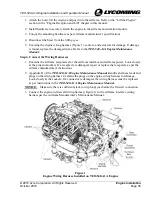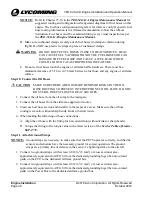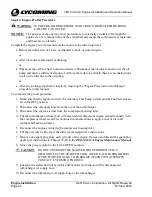
© 2018 Avco Corporation. All Rights Reserved
Engine Initiation
October 2018
Page 49
TEO-540-A1A Engine Installation and Operation Manual
Pre-Flight Inspection Checklist for Engine Initiation (Cont.)
Examine the engine and cowl for indication of fuel and
engine oil leaks.
Identify and correct the cause of
any leaks.
Make sure that all baffles and baffle seals are installed in
the correct position and are serviceable.
Look in the engine compartment and cowling for
unwanted material, loose, missing fittings, clamps and
connections. Examine for restrictions to cooling airflow.
Remove any unwanted material.
Tighten any loose connections
per torque values supplied by
the aircraft manufacturer.
As necessary, add fuel specified (in Appendix A) to the
aircraft in accordance with the airframe manufacturer’s
instructions.
WARNING
DO NOT ROUTE FUEL HOSES OR OIL HOSES CLOSE TO HEAT
SOURCES. HEAT CAN DAMAGE THE FUEL AND OIL HOSES AND
CAUSE A LEAK WHICH COULD LEAD TO CATASTROPHIC ENGINE
FAILURE.
Examine fuel and lubrication lines:
A.
Make sure that each fuel hose and oil hose is
intact, not bent or damaged, and does not have
any kinks or dents.
B.
Make sure that the fuel hoses and oil hoses are
securely connected.
C.
Make sure the clamps are tightly attached to
support the fuel and oil hoses and to prevent
movement from vibration. Do NOT use plastic tie
straps in place of cushioned clamps.
D.
Do not let fuel and oil hoses touch the engine or
aircraft baffle hardware. There must be a
minimum of clearance of 3/16 in. (4.76 mm)
between fuel and oil hoses and any engine or
aircraft surface.
NOTICE:
Record any problems found and corrective action taken in the engine logbook. Record
the magnitude and duration of a problem and any out-of-tolerance values.
Correct all problems before engine start. Refer to the
"Engine Conditions" chapter in this manual.
Complete a flight test per the section “Step 8. Break-
In/Flight Test/50-Hour Operation” in this chapter.
















































